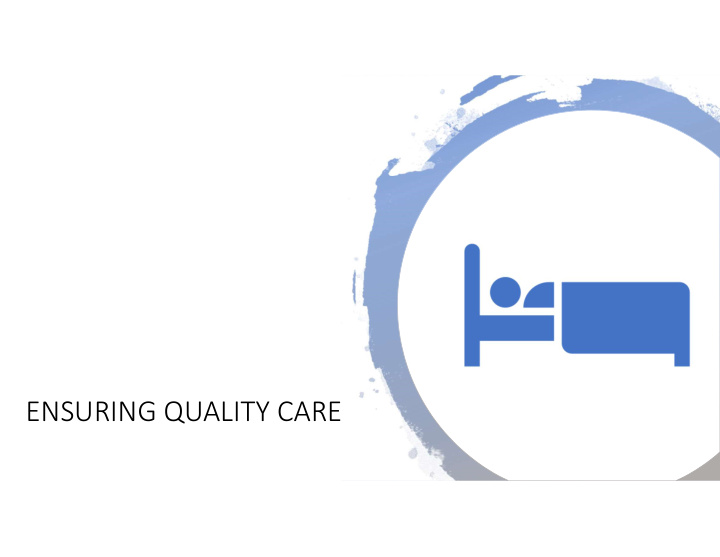



ENSURING QUALITY CARE
FOOT CARE September 2019 Safety, Oversight and Quality Unit
PURPOSE AND KEY TERMS • Bunions The purpose of this section is to assist the learner in acquiring a • Corns deeper understanding of the • Calluses importance of foot care needs in • Ingrown, thick or brittle toenails view of age-related changes and general health conditions of the resident. September 2019 Safety, Oversight and Quality Unit 2
OBJECTIVES The learner will be able to: Describe common foot problems and the potential causes Describe general guidelines for foot care Explain why a health professional should cut nails of residents with difficult nails, circulatory problems or diabetes Discuss the importance of inspecting feet daily September 2019 Safety, Oversight and Quality Unit 3
INTRODUCTION Foot health adds to the well-being of all residents, however, providing proper foot care and preventing foot problems can be a challenge. Painful feet are a common problem. Many people do not take foot care seriously and use drug store remedies instead of seeking medical treatment. They forget how much their quality of life and independence depend upon their feet. September 2019 Safety, Oversight and Quality Unit 4
COMMON PROBLEMS Painful feet have consequences: • Sore feet may prevent a person from walking • Less exercise reduces fitness and stamina, which in turn affects the person’s sense of well-being and the ability to be as independent as possible The risk of falling increases if their sensitive feet cause them to wear loose-fitting shoes, bedroom slippers or no shoes at all. September 2019 Safety, Oversight and Quality Unit 5
COMMON PROBLEMS CONTINUED A resident with poor vision who goes barefoot risks injuring their feet: • If the resident is less sensitive to pain, an injury to the feet (e.g., a burn, cut, bruise or fracture) may go unnoticed and untreated • Foot problems often result from disease, improper walking habits, poor foot care, ill-fitting shoes, decreased circulation and toenails that are not properly trimmed September 2019 Safety, Oversight and Quality Unit 6
COMMON PROBLEMS CONTINUED Delayed healing: • Diabetes, edema or decreased blood supply to the feet delay healing • Injury or mistreated feet increase the risk of amputation Corns and calluses: • Corns are painful, round areas of thickened skin • Calluses are hard, thickened areas of skin that are normally thick, such as on soles of the feet and palms of hands • Both are a response to repeated friction and pressure, mainly from shoes – encourage the resident to wear proper fitting shoes and stockings or socks September 2019 Safety, Oversight and Quality Unit 7
COMMON PROBLEMS CONTINUED • Discourage use of corn pads, razor blades or chemicals to remove corns and calluses • Remedies advertised as cures for corns contain acid that destroys skin tissue, they do not treat the cause Bunions: • Occur when big toe joints are deformed and shoes are poorly fitted – the shoes press against the out-of-line joints, causing the toes to become swollen and tender • Encourage shoes that have wide instep and toes, and protective pads that cushion the painful areas September 2019 Safety, Oversight and Quality Unit 8
COMMON PROBLEMS CONTINUED Ingrown, thick or brittle toenails: • Involves the big toe and is caused when an improperly trimmed nail pierces the skin • Encourage the resident to cut nails straight across and level with the top of the toe • Wear leather shoes with round toes that extend about one and one-half inches beyond the longest toe, which helps keep pressure off the ends of toes Swelling: • Discourage wearing tight stockings or garters, sitting or standing for long periods of time or crossing legs at the knees or ankles September 2019 Safety, Oversight and Quality Unit 9
COMMON PROBLEMS CONTINUED Burns – encourage wearing shoes outdoors – the sun and hot pavement can burn feet. Inspect feet daily, especially if they have diabetes or other chronic illnesses that reduce blood flow. Protect feet from hot and cold – if feet are cold at night, have the person wear socks: • Do not use a hot water bottle or heating pad to warm feet • Discourage residents from using their feet to test the water September 2019 Safety, Oversight and Quality Unit 10
GENERAL FOOT CARE Wear shoes that fit and are comfortable: • Foot size changes as you grow older so always have your feet measured before buying shoes • Feet are the largest at the end of the day, which is the best time to buy shoes or have your feet measured Encourage residents to put their feet up when sitting. Have residents wiggle their toes and move their ankles up and down for five minutes, two or three times a day. Don’t ignore foot pain. If a resident complains of foot pain, encourage the person to see a health care professional. September 2019 Safety, Oversight and Quality Unit 11
SOAKING THE FEET Encourage residents to soak their feet. Soaking the feet promotes relaxation and allows the care provider to examine the person’s feet: Caution: Soaking is not advisable for all residents. For example, those who have diabetes should not soak their feet. Consult a health care professional to be sure this procedure is safe. September 2019 Safety, Oversight and Quality Unit 12
DISCUSSION/QUESTIONS Safety, Oversight and Quality Unit September 2019
Recommend
More recommend